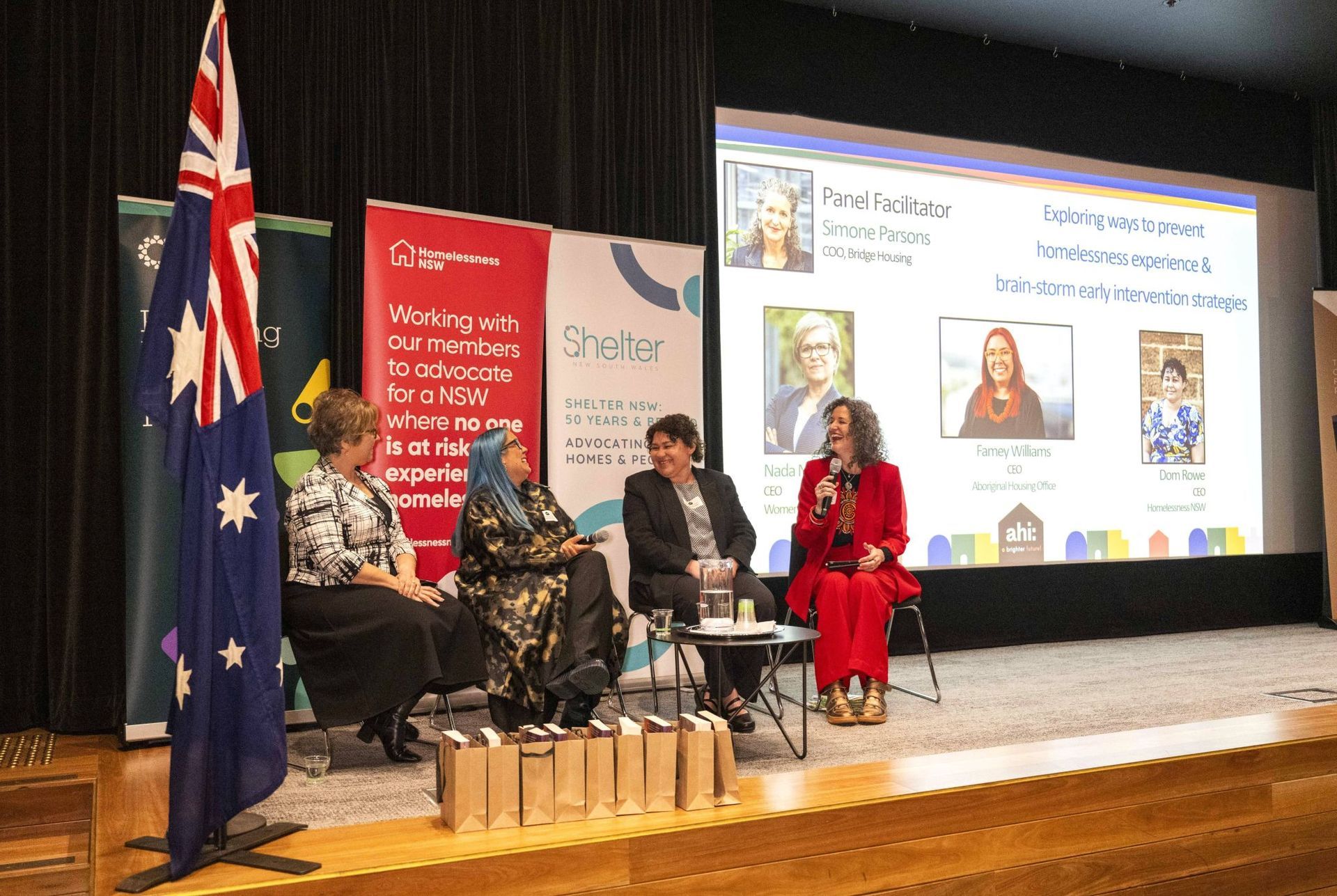Growing Together Conference Programme
On Tuesday 26th and Wednesday 27th November at AUT City Campus in Tamaki Makaurau, Auckland, Community Housing Aotearoa (CHA) held their annual conference with the theme ‘Growing together––sharing our knowledge’. Following are a brief overview and transcriptions of the two plenary speeches from Government.
Over 500 people attended the CHA 2024 Conference in person, with more than 400 people joining online for the two-day event. Additionally, two site tours of housing community housing providers and their properties were booked out and blessed with good weather and safe travels.
Both Ministers of Housing, Hon. Chris Bishop and Hon. Tama Potaka, opened each day of the conference respectively, to make housing-related announcements (see below).
The CHA would like to acknowledge and thank hosts, AUT; sponsors and exhibitors; and all those who enabled housing professionals to come together in Tāmaki Makaurau. A huge mihi to facilitators who provided a range of thought-provoking and sometimes challenging working sessions inviting everyone to participate, share and learn.
Also, thanks to the team at Conference & Events, Amy and Jen who effortlessly guided everyone through the event and the venue. Ngā mihi nui ki a koutou katoa.
The recordings of the plenary and keynote speakers are now available on CHA’s Youtube channel.
Keep an eye on the CHA website – presentations, workshop notes and photos will be added as they’re received.
SPEECH FROM HON. CHRIS BISHOP
Our housing crisis
Sometimes people try to think of social and affordable housing in its own little bucket, as if it can be divorced from the rest of the housing system.
It can’t.
The truth is, that our failure to create a functioning housing market has created a cascading series of extremely difficult and expensive public policy problems to solve, with a real human cost.
You know all the stats, so I won’t dwell on them too much.
After inflation, house prices in New Zealand increased by more than any other OECD country in the past 30 years. Between 2000 and 2021, inflation adjusted house prices rose 256%.
In the year to June 2023, 45% of renting households spent at least 30% of their post-tax income on housing. Research by the OECD shows that this is even higher for low-income households, and higher in New Zealand than any other country.
“There are around 21,000 families on the social housing wait list.”
And in the last few years, we have seen the human disaster that is emergency housing, where, in 2022, the government was spending $1 million on average per day to house people in motels around the country.
Our housing crisis is phenomenally expensive for government.
Central government spent over $5 billion last year alone on housing assistance in many different forms. That includes the accommodation supplement, Income Related Rent Subsidies, emergency housing grants, transitional housing and initiatives to address homelessness.
Each new government programme has begat another government programme; and they have grown like mushrooms. The system is complicated, confusing, and often duplicative. Most importantly, it is extremely expensive.
If that $5 billion amount stayed flat, over the four-year budget period the New Zealand government will spend over $20 billion just on helping people to be housed.
To put it is perspective, that’s 15 Transmission Gully motorways, or two thirds of Central Government’s school property portfolio, or billions of dollars more than our entire network of hospitals – an astonishing amount of money.
Our housing crisis is most importantly a moral issue. A generation locked out of home ownership. Kids growing up in motels. People living pay cheque to pay cheque just to afford rent. A long list of families in housing need who can’t get access to a warm dry home.
All our problems in housing are connected to each other and our Government is determined to fix our housing crisis by focusing on the fundamentals––our Going for Housing Growth policy, improving the rental market, making changes to lower construction costs, reforming of our planning laws and improving social housing.
Progress we’ve made already
Tomorrow marks the anniversary of the Government’s first year in office.
I’m pleased with the progress we’ve made so far.
We are ending the blight that is emergency housing. Latest reporting shows that that there are only 993 households in emergency housing––down from 3,405 when we came to government. That’s a 71% decrease.
This has come from a sustained focus by MSD workers into getting our most vulnerable people into houses––either social houses or private rentals.
More than 1,600 kids have moved out of motels into housing thanks to our Priority One initiative, which we campaigned on and implemented soon after coming to government.
The social housing waitlist (public housing register) is down to around 21,000. It is still too high, but it is about 4,000 fewer than it was a year ago.
In building and construction, Chris Penk is making changes to make it easier to build. We’re reforming the building consent system, removing barriers to overseas building products to increase competition, increasing the use of remote inspections, and much more.
We’re also changing the law to make it easier to build granny flats of up to 60 square metres, without a building consent or resource consent.
The centrepiece of our housing policy is Going for Housing Growth.
It consists of three pillars that address the root cause of our housing crisis––freeing up land for development and removing unnecessary planning barriers, improving infrastructure funding and financing, and providing incentives for communities and councils to support growth.
Report after report has found that our planning system, particularly restrictions on the supply of urban land and infill opportunities, are at the heart of our housing affordability challenge.
The first pillar of Going for Housing Growth has been announced and involves the establishment of Housing Growth Targets for Tier 1 and 2 councils, new rules to make it easier for cities to expand outwards at the urban fringe, a strengthening of the intensification provisions in the NPS-UD, new rules requiring councils to enable mixed-use development in our cities, and the abolition of minimum floor areas and balcony requirements.
These changes will be advanced through a Resource Management Amendment Bill to be introduced before the end of the year, and National Direction changes next year.
Pillar two about ‘infrastructure funding and financing for urban growth’ is very important and I’ll have more to say on that soon.
Social housing
That brings me to our social housing system.
One of the first things we did on coming to government was commission an independent review into Kāinga Ora.
We were worried about it in Opposition, and it turns out we were right.
The last government was well practiced at throwing money at things, and Kāinga Ora was no exception. It had easy access to debt, hundreds of millions of dollars allocated to it, and was asked to do everything from urban development, infrastructure grants, a shared equity scheme, first home grants, specified development projects––as well being a landlord to and looking after tenants!
Despite billions thrown at it and billions borrowed, the waitlist quadrupled under the last government.
As you know, there is a new Board in place at Kāinga Ora and the first thing we did was ask for a Turnaround Plan.
Last week Ministers received that plan.
It is critical that Kāinga Ora is a highly performing organisation––not just for the Crown’s books––but for the people it houses and for the communities it operates in.
Once Cabinet has considered the plan, we will release it publicly and the next steps for Kāinga Ora.
In the meantime, we know it is important to keep construction of social housing going. The previous government’s 3,000 new social housing places involved funding until only June 2025, so we allocated $140 million in Budget 2024 to new social housing places to be delivered only by CHPs. This was funded from ending the First Home Grant scheme, a classic example of low value expenditure being reprioritised to fund higher value priorities.
Back in May, I signalled that around 500 homes would be allocated quickly based on the existing pipeline to ‘maintain momentum’. I am pleased to say that, as of October, around 100 social housing places for June 2025 onwards have either been approved or are in the final stages of consideration, and my officials tell me there is a strong pipeline of proposals.
Most of the remaining 1,000 places are to be allocated using strategic partnerships, with the aim of targeting areas where the need is most acute.
Under this new approach, strategic partners will be funded to deliver social housing at a portfolio level, as opposed to looking at proposals one by one. This will help build more enduring capacity and capability.
The Ministry of Housing and Urban Development has selected a small number of CHPs to start work on strategic partnerships. A formal announcement of the selected partners will be made once those agreements have been confirmed.
While most of the 1,500 places will be delivered through ‘maintaining momentum’ and strategic partnerships, there will still be some room for CHPs to deliver projects outside of this.
Competitive neutrality
My ambition for the social housing system is to create a level playing field between CHPs and Kāinga Ora.
Put it this way: I don’t care who builds social and affordable houses, as long as they get built.
The last government was obsessed with state housing.
I’m obsessed with building houses across the housing continuum for people who need them.
I am agnostic as to whether those houses are delivered by community housing providers or the government.
The truth is: we won’t solve our housing crisis through the government alone.
I call this ‘competitive neutrality’. In some areas and for some people, CHPs are the answer. In other areas, Kāinga Ora is the way to go.
However, we don’t have competitive neutrality right now.
As I am sure you are aware, Kāinga Ora can borrow at a small margin above the Crown’s cost of financing, while CHPs effectively get access to finance only at commercial rates.
Announcement
Over the last year, I have heard from you, major banks, intermediaries and investors that access to finance is a concern for CHPs.
I want to give the sector assurance that the Government has heard you and is committed to creating that level playing field.
Today I can announce three actions the Government is taking now to help CHPs access borrowing to deliver new social housing.
The first is making the Operating Supplement available upfront.
To improve the confidence around the delivery of the 1,500 places, the Government will make $70 million of Operating Supplement available upfront, that would otherwise be paid to CHPs over time.
The purpose of this upfront funding is to unlock the equity CHPs require to raise debt finance where they otherwise wouldn’t have been able to. For instance, I know that it can be tough to get financing in regional locations where banks may require more equity.
This will ultimately mean more community housing projects will meet financing criteria, and those projects can be advanced sooner.
Second, changes to IRRS Contracts
I have directed the Ministry to make targeted changes to IRRS contracts for new housing supply that makes the revenue stream more attractive for financiers.
There are several clauses in HUD’s contracts that investors repeatedly emphasise as problematic. These add to the perceived risk of the transactions and therefore increase the cost of financing or deter investors altogether. There are also operational measures HUD has identified to help mitigate some of the cash flow risks that investors have identified.
I am leaving this work with my officials to follow up with CHPs in the coming months.
Three, using leasing
On top of the IRRS contract changes, I have also instructed the Ministry to review the use of leasing to provide social housing, in cases where it provides value for money.
There is already significant interest from private developers and investors in partnering with CHPs to help them deliver and operate social housing.
Over the coming months and into the new year, the Ministry will review and reset its framework for leasing.
There are many leasing terms and structures. The Ministry’s framework will consider what happens at the end of the lease term and what the options are for CHPs, for Government, and for the tenants at that stage.
Reserve Bank
We have also heard what CHPs have said around Reserve Bank rules. Broadly, we agree with you and think the risk weights may be overcooked for lending for social housing.
The Minister of Finance will soon request that the Reserve Bank undertake a review of standardised risk weights, including prioritising work on lending for social housing.
Over time, and as the social housing sector grows, there is the potential for changes through that review to increase competition and place pressure on the cost and terms of debt financing.
But banks are not the only source of debt financing for CHPs or their partners. In other jurisdictions, financing for the operating phase tends to come from lenders that can be more flexible to meet the needs of the sector, such as capital markets. This is an area where I am seeing a lot of opportunities and potential for innovation.
Credit enhancement
That brings me to my next announcement.
I am pleased to announce that the Government is committed to exploring a credit enhancement intervention for CHPs, so that they can access suitable debt.
Over the next three to four months, the Government will consider a range of options to support CHPs’ access to debt on terms reflective of their real risk and circumstance.
These options include, but are not limited to:
- providing direct lending or guarantees to CHPs;
- establishing a Crown intermediary to provide financing efficiencies; or
- providing lending or guarantees to a private lender.
CHPs having access to financing that is not unnecessarily restrictive gives them a stronger economic case for building more social houses and goes some way to levelling the playing field with Kāinga Ora.
The days of the state preferring its own entity are over.
But––I will be blunt––this work will take time, and there are many details to comb through. I have requested that the Treasury, with support from the Ministry of Housing and Urban Development, report back to me early next year with details on a fulsome credit enhancement proposal for consideration next year.
Depending on what that looks like, it also may take some time to implement.
I’m being realistic about timelines, because I don’t want you to wait for the Crown and put a break on the fantastic momentum that we want the CHP sector to continue.
Review of housing funds
I’m coming to the end of my time with you, but I know you’re probably wondering what is happening to the rest of the Kāinga Ora Review recommendations around ‘active purchasing’ and community housing associations.
Our major focus this year has been to reset the organisation. At the same time, we also started a comprehensive look at all the funds the Government uses across the housing system.
What is clear to me is that the system is messy, opaque, expensive and often duplicative.
We can create better institutional structures that enable investment discipline and certainty. We can create simpler and clearer funding streams for CHPs and Kāinga Ora to access. We can be far more deliberate about where and when we invest, based on much greater use of granular data about housing and social need.
So that work is coming together, and I’ll have more to say in the new year.
Conclusion
Let me conclude by finishing where I started, which is saying thank you for what you do.
Together, we will solve New Zealand’s housing crisis. I’m looking forward to continuing to work with you.
SPEECH FROM HON. TAMA POTAKA
Emergency housing and the goals achieved
When I, and my colleagues, came into government on this date one year ago, I moved into an empty office on the fourth floor of the beehive. When I met my housing team on day one, I said my biggest priority for housing is to get tamariki out of emergency housing.
Yes, the costs were too high at one million dollars a day, and yes there were too many people. Both important, of course, but for me, the biggest issue was too many tamariki.
In November 2023, there were 3,342 households in emergency housing. Of that, nearly 3,600 children were living in emergency housing. (3,588 for both MSD EH and HUD CEH).
This was not at all a good use of money, nor would it have led to successful outcomes. If you’ve heard me in Parliament speaking on this issue, you’ll know I’ve said time and again that the long-term, large-scale use of emergency housing when we came in was a moral, financial and cultural catastrophe.
We also campaigned on this pre-election by saying that we were committed to ending the large-scale and long-term use of motels for emergency housing.
The first key change we made was to ensure emergency housing returns to its original purpose, which is a last resort for those with genuine need for a short-term and non-recurring.
To achieve that, the Government has set a target of reducing the number of households in emergency housing by 75% by 2030.
As the starting point for the target was the December 2023 emergency housing numbers which held 3,141 households, the target is to get down to 800 households in emergency housing by 2030.
Te Tūāpapa Kura Kāinga – Ministry of Housing and Urban Development and Te Manatū Whakahiato Ora – Ministry of Social Development are jointly responsible for delivering the target, and I am proud to be the Minister responsible for leading this important mahi.
I’m very proud to stand here today to announce that, as at end-October, we are now under 1,000 households in emergency housing (993 EH and CEH).
Several factors have contributed to the decline including:
- Ensuring eligibility and expectations for emergency housing are clearer, so that emergency housing is targeted to those in greatest need;
- Prioritising families with children who have been in emergency housing longer than 12 weeks into social housing;
- Increased social housing supply; and
- Continuing housing support services and products to assist people into private rentals, to prevent them needing emergency housing.
The second change was to target children living in emergency housing through our Priority One category.
In March this year, Cabinet approved the policy to put adults with children living in emergency housing for longer than 12 weeks on the top of the social housing register, alongside the other two fast-tracks being those with Rheumatic Fever and Oranga Tamariki referrals.
Priority One went live on 30 April 2024 and as at end-October there were 786 households that shifted from emergency housing into social housing. A number of you hold some of those families, the overwhelming majority are being housed by Kāinga Ora.
Of those 786 households moved into social housing under Priority One, 1,608 were tamariki. This is a great number.
The third change we made is more recent but is trialling a social outcomes contract in Wellington and Hamilton (as they have the most households in EH now) and supporting singles and couples in emergency housing without children, to get out and hopefully stay out with the support from service providers.
Earlier this month (13th November), I was pleased to announce the trial of a new social outcomes-based contracting model, for people with a diverse range of complex needs to move out of emergency housing and into permanent homes.
Wellington City Mission and Emerge Aotearoa in Waikato are the first organisations to take part.
The trial is a focused support service for 50 to 100 people who don’t have children living with them, and who have been in emergency housing for an extended period. And they are not in other housing support services such as Housing First, Rapid Rehousing, transitional housing, or part of MSD’s Navigator service.
The trial will support people to move out of emergency housing into more stable housing, rather than fund housing itself, and will run for two years.
Wellington and Hamilton were chosen because of the high number of people in emergency housing in these locations, particularly single people or couples without children. As numbers in EH have decreased significantly, this cohort makes up a higher proportion of those left in EH.
Single people and couples without children can often face higher barriers to moving into stable accommodation and are not assisted by other interventions such as the Priority One fast track for whānau with children. Some of these people have been in emergency housing for extended periods.
The trial aims to identify those barriers and provide tailored supports to help them move into and sustain stable housing.
Stable housing may include private rentals or social housing, but it cannot include housing that is considered temporary - for example, hostel or backpacker accommodation, or transitional housing.
This trial will take a ‘learning by doing’ approach. HUD monitor how the trial is going and make any necessary adjustments over the two-year period.
The key elements of the trial:
- It is flexible about how providers deliver their services and focused on outcomes (achieving sustaining stable housing);
- It includes outcome payments that will be made when the provider has supported a person to sustain stable housing over time (for example 3 months, six months and 13 month);
- It includes a flexible funding element where providers will tailor their approach and solutions to fit the individual situation. Tailored approaches are important because, for many of these people, standard approaches have not worked.
Examples could include support for enrolment in primary healthcare, budgeting, employment and counselling services, support to open bank accounts and manage a tenancy agreement, gain a driver’s licence, or re-engage with family and community support. It will be up to the service providers to determine how best to support each client in the trial.
The effectiveness of this trial will be measured through an independent process evaluation, and rapid impact monitoring in partnership with the Social Investment Agency. These will inform investments in future social investment outcomes contracting initiatives for housing and elsewhere.
Māori housing partnership with the CHP sector
Since becoming Associate Minister of Housing last year, I have already seen many examples of the partnership between Government and CHPs delivering warm, stable homes for whānau Māori.
An example of this partnership is Te Hau Ora o Ngāpuhi, a Māori CHP. They are working with the Ministry of Housing and Urban Development to deliver Te Kohekohe.
This development is the largest community housing development in the far north with 60 units but also the country’s first housing complex co-owned and co-built between iwi and a council-owned organisation. A living example that connects to this year’s theme – growing together.
More recently, I had the pleasure alongside my colleague, the honourable Chris Bishop, to celebrate an opening of a 12-home project in Porirua with Māori CHP – Te Ahuru Mōwai.
As Tā Matiu Rei (Chairperson of Te Ahuru Mōwai) said at the opening: “Twelve more whānau will have homes in Porirua as a result of this mahi, and we look forward to providing many more warm, dry, safe and beautiful homes in the near future.”
We cannot forget the amount of support Te Matapihi and CHA give to CHPs and this is evident in the increased number of Māori CHPs – currently 35 registered Māori CHPs out of 87. This means about 40% of the total register is made up of organisations that self-identify as Māori.
Te Matapihi are in a unique position to engage closely with government and Māori. They have a wealth of knowledge and experience that they provide to Māori CHPs in particular.
CHA supports the growth and development of CHPs; enabling them to provide social and affordable housing has been a complementary element in our partnership to housing solutions.
Māori housing partnership
Wider than the Government’s partnership with Māori CHPs is our partnerships with landowning Māori entities for affordable housing, whether that be rentals or home ownership or papakāinga.
Today I’m also proud to announce that the Government has given the green light to provide funding of NZD$81 million for 12 resource-consented projects to enable about 200 affordable rental homes. These homes will be in partnership with Māori landowning entities, and they will support the many whānau who struggle to pay a market rental.
Social housing
As you know, delivering better social housing is a priority of the Coalition Government as part of our housing agenda for New Zealand.
If you look back over the past 12 months, there are some notable changes in the numbers. There are 21,294 people on the social housing waitlist––which is 4,139 fewer than at the end of October 2023.
On the transfer register––people who are already in social housing and want to move to social housing in another location––is currently 4,836 people, which is 257 fewer than at the end of October 2023
However, some statistics are harder to shift. Of the people who live in social housing – 49% were Māori, 37% European, 18% Pacific Peoples, and the remainder comprised of other ethnicities.
As you know, the Ministry of Social Development (MSD) is responsible for the administration of the Social Allocation System, which determines eligibility and priority for social housing based on the applicant’s assessed need.
The process as you are aware is for Kāinga Ora and CHPs to advise MSD, which is responsible for managing the register of eligible applicants, when a social housing property becomes vacant.
MSD then shares a short-list of the 20-30 highest priority applicants whose housing need and locational requirements match those of the vacancy.
The housing provider then selects the highest priority applicant they consider best-suited to the property and undertake a pre-placement interview before making a formal property offer.
MSD’s role is to assess and prioritise need and share with housing providers short-lists of suitable applicants, but the decision to make an offer of social housing rests with the landlord/provider.
MSD and Kāinga Ora have sought to strengthen connections at the national and local level through more frequent and focused interaction between senior leaders to improve the efficacy of the social housing placement process reflecting the Government’s priority on quickly supporting whānau with children out of emergency housing into suitable and sustainable housing.
Social housing allocation (Priority One)
As we work towards achieving this target, our first focus has been to move whānau with tamariki out of emergency housing motels and into more stable housing through our Priority One policy.
The Priority One policy is a key election promise from National, enabling whānau with tamariki who have been in emergency housing for 12 weeks or more to move into social homes.
At the end of October 2024, we have had solid success with Priority One, which has seen 786 households––including 1,608 tamariki––moved from emergency housing into social housing since its introduction in April.
For example, there was a mother who said her seven tamariki were thriving after moving from an emergency motel into social housing after a long period.
The mum said, ‘The children have been able to stay in the same schools and are doing well and the older children are starting to think about future careers. With our new home and a quiet place to do their homework, they can focus on their schooling and make the most of every opportunity that comes their way’.
I also recently met a dad who had been moving between homeless shelters, a caravan and his car. He told me that moving into his home earlier this year has been life-changing for him and his daughter. His teenage daughter is now settled, achieving excellence at school and he told me that his daughter now has goals in life.
Accessing emergency housing
MSD has strengthened the verification processes for those entering emergency housing (EH) by reviewing eligibility settings and introducing new obligations.
MSD is looking more closely at whether someone applying for emergency housing has contributed to their housing need, if they can stay in their current accommodation, whether they have previously paid their emergency housing contribution, and their expectation to look for and accept offers of suitable accommodation including private rentals and transitional housing.
Where people aren’t meeting their responsibilities, they may not be able to access or stay in emergency housing.
The Government has sought to mitigate risks associated with tightening the gateway for emergency housing in a number of ways.
We have continued investment in EH support services and additional financial products to support people into sustainable homes. We are changing policy settings to enable housing growth and funding CHPs to build 1500 new homes.
In addition, there is ongoing work underway to assist people transitioning from state care.
As part of the wider programme of work, MSD has received funding to continue support services, such as housing brokers, navigators and ready-to-rent courses.
We’ve also expanded how we can help people stay in their home or get a new place by making housing support products available to more people in a wider range of situations.
That brings me to our latest innovation in the emergency housing space.
Conclusion
Paul and Ali, you are helping us chart a remarkable course for the delivery of social housing by community housing providers in Aotearoa. My deepest thanks to you both, and all of those who attend the Community Housing Aotearoa Conference and your commitment to this important mahi.
Tēnā koutou, tēnā koutou, tēnā tātou katoa.
Share This Article
Other articles you may like











